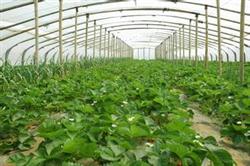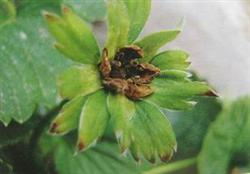How to get early ripening and High quality Big Fruit of Strawberry in greenhouse

In recent years, the cultivation technology of early maturity, high quality and large fruit of strawberry in greenhouse has advanced the marketing time of strawberry to the middle of December, and the quality of strawberry produced is good, the average single fruit weighs about 30 grams, and the average yield per mu is 1800 kg, which greatly improves the planting benefit of strawberry. Select good seeds. Strawberry varieties selected should adapt to local soil and climate conditions and have strong resistance to pests and diseases. We chose Fengxiang as the main variety, and planted a small number of Mingbao varieties. 1. Establish special seedling breeding fields. Paddy fields with convenient irrigation and drainage and high soil fertility should be selected so as to timely divert water and drought resistance in high temperature and dry season, reduce ground temperature and ensure successful seedling cultivation. Sprinkle 50% phoxim 0.5kg or 3% carbofuran 1- 1.5kg/mu mixed with 25kg fine soil to control underground pests. 2. Seedling transplanting. From April 15 to 20, when the daily average temperature is about 15 DEG C, seedlings are planted into seedling breeding fields. The seedling breeding field is 2 meters wide, and one row of seedlings is planted in the middle of the bed. Plant spacing 0.8 meters, planting 416 plants per mu, each seedling can reproduce about 100 seedlings. The artificial planting time is from the end of July to the beginning of August, the seedling age is controlled at 45-50 days, the plant spacing is 12 cm ×15 cm, and the shade net is covered after planting. Remove buds regularly to reduce nutrient consumption. In this way, 35,000 - 40,000 seedlings with more than 4 leaves can be bred per mu, and about 5 mu of fields can be transplanted. 3. Seedling field management. 1000-1500 kg of decomposed pig sheep ash and 20-25 kg of calcium superphosphate are applied as base fertilizer for each mu of seedling breeding field. After the plants live, apply diluted dung water once, and apply urea 5kg per mu every 10-15 days. In case of high temperature and drought, furrow irrigation keeps soil moist. 10 days after planting, pyrethroids or 40% omethoate 1000-1500 times solution was used alternately to control the disease twice, and 50% carbendazim or 70% thiophanate-methyl 800-1000 times solution was used to control the disease twice every 7-10 days. Artificial weeding 2-3 times. Early-maturing and high-yielding cultivation 1. Planting. Before planting, 2000-2500 kg of decomposed pig manure fertilizer, 50-75 kg of rapeseed cake, 30-40 kg of potassium sulfate compound fertilizer and 30-40 kg of calcium superphosphate are applied as base fertilizer per mu. The planting time is September 5-15. Ridge width 1 meter (continuous ditch), height 30 cm, 2 rows per ridge, 6 rows 12 rows of strawberries planted in each greenhouse, density 7500 plants per mu. 7 days after planting, when the strawberry heart leaves are bright, 500-750 kg of diluted manure water or 2.5-4 kg of urea are applied to the water for 1-2 times per mu. 2. Early prevention and treatment of pests. Try to choose biological pesticides, high efficiency and low residual pesticides. In case of continuous rainy days for 5-7 days, use Sukeling fumigant to control gray mold 1-2 times in the evening to ensure high quality fruit. 3, the use of drip irrigation technology. Drip irrigation technology is mainly used to control water in middle and late strawberry. The traditional furrow irrigation method is easy to cause high humidity in the field. The drip irrigation technology can save water and ensure no pollution. 4. Peaking and thinning flowers and fruits. The method of artificial pollination and placing a box of bees in each greenhouse was adopted. It can improve pollination rate, fruit setting rate and yield. Timely pluck excrescence bud, old leaf, disease leaf and stolon, the flower bud of rank order is tall, small fruit and a few aberrant fruit. 5. Temperature and humidity regulation. From the end of October to November 5, cover the greenhouse film and plastic film. Before and after budding, the temperature in the shed was kept at 25-28℃ during the day, 24-26℃ during flowering and fruiting, and 20-24℃ during fruit picking. The humidity in the shed shall be controlled within 70%. If the humidity is too high, proper ventilation and humidity dissipation shall be conducted at noon on sunny days. At 8-9 o 'clock in the morning, the strawberry heart leaves do not spit water or drip irrigation when the mulching film on the ridge is uncovered and the topsoil is white, which can not only control the occurrence of diseases, but also facilitate normal pollination at flowering stage. 6. Furrow grass. At the end of November, 150kg of fresh dry straw is spread in the furrow of each greenhouse, and 500- 600kg of organic fertilizer is applied to make the furrow straw ferment and warm, and slowly release carbon dioxide gas fertilizer, which can increase the temperature in the greenhouse by 1.8-2℃, improve the yield and disease resistance of strawberries, and promote the early maturity of fruits. 7. Harvest at the right time. In winter or early spring, the fruit should be harvested when the fruit is mature and the color of the fruit surface reaches more than 90%, and at the end of March of the following year, the fruit should be harvested when the fruit is mature.
- Prev

How to improve the fruit setting rate of winter jujube
How to improve the fruit setting rate of winter jujube
- Next

What to do about strawberry lack of potassium and magnesium in greenhouse
Potassium deficiency: the symptoms of potassium deficiency in strawberries often occur in the newly mature upper leaves. The edges of the leaves are often black, brown and dry, followed by burns, and they also develop to the center between the veins of most leaves, and the old leaves suffer seriously. Light can aggravate leaf burns, so potassium deficiency is often confused with sunburn.
Related
- Moge, come on! The staff of the peasant association in the producing area of cantaloupe were frightened when the crowd gathered.
- Causes and Solutions of low Fruit setting rate of Apple
- Symptoms and control measures of passion fruit virus disease
- Fruit growing lesson: how do apple orchards keep high yields?
- Can you build orchards in the mountains? What are the pros and cons?
- How to manage the coloring period of Crisson grape?
- This paper introduces the processing technology of two kinds of fig products.
- How much is a month for retired teachers in rural areas by 2020?
- How can strawberry planting increase sugar content? We should pay attention to management in many aspects.
- What are the cultivation techniques on how to improve the yield of golden fruit?

